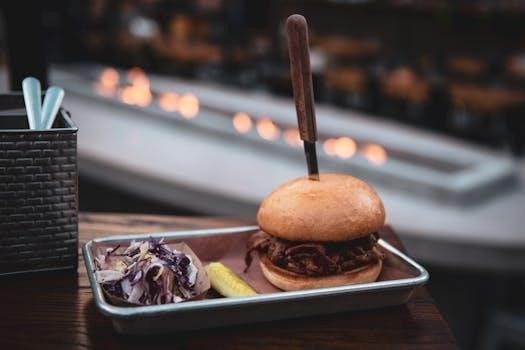California Meal Break Waiver Form⁚ A Comprehensive Guide
Navigating California’s meal break laws can be complex, especially when considering waivers. This guide provides a comprehensive overview of the California meal break waiver form, outlining its purpose and when it is permissible under state labor regulations. Understanding these rules is crucial for both employers and employees.
California meal break law mandates that employers provide employees with meal breaks, ensuring worker well-being and productivity. These regulations aim to prevent employee fatigue and allow adequate time for rest and nourishment. Generally, employees are entitled to a 30-minute unpaid meal break for every five hours worked.

However, California law recognizes specific instances where these meal breaks may be waived. A meal break waiver allows an employee to voluntarily forgo their meal break under certain conditions. These waivers are not universally applicable and are subject to strict requirements to protect employees from exploitation.
The California meal break waiver form serves as documentation of the agreement between the employer and employee to waive the meal break. It’s important to note that these waivers are only valid under specific circumstances, such as when the employee works six hours or less, or in the case of a second meal break waiver for shifts lasting between ten and twelve hours, provided the first meal break was not waived.
This guide delves into the intricacies of California’s meal break law, focusing on the conditions under which a meal break waiver is permissible, the requirements for a valid waiver form, and the rights of both employers and employees in this context. Understanding these regulations is crucial for compliance and ensuring fair labor practices.
General Meal Break Requirements in California
California labor law mandates specific meal break requirements for employees. Generally, employees are entitled to a 30-minute unpaid meal break when working more than five hours in a workday. This meal break must begin before the end of the employee’s fifth hour of work. The purpose is to ensure employees have adequate time to rest and eat, promoting their well-being and productivity.
For employees working more than ten hours in a workday, a second 30-minute meal break is typically required before the end of their tenth hour of work. However, there are exceptions and waivers that can modify these general rules.
Employers are responsible for ensuring that employees are relieved of all duty during their meal breaks. This means employees should not be required or expected to perform any work-related tasks during this time. Employers must also not discourage employees from taking their meal breaks.
It’s important to understand these general requirements before delving into the specifics of meal break waivers. While waivers allow for deviations from these rules, they are subject to strict conditions and limitations to protect employee rights. Failure to comply with California’s meal break laws can result in significant penalties for employers.
Conditions for a Valid Meal Break Waiver
A California meal break waiver allows an employee to voluntarily forgo their required 30-minute meal break under specific conditions. Several key requirements must be met for a waiver to be considered valid and legally compliant.
First and foremost, the waiver is only permissible when the employee’s total workday does not exceed six hours. If an employee works longer than six hours, a meal break waiver is strictly prohibited. This limitation ensures that employees working longer shifts receive the mandated break for rest and nourishment.
Secondly, the agreement to waive the meal break must be genuinely mutual and voluntary. Both the employer and the employee must freely consent to the waiver, without any coercion or pressure from the employer. Employers cannot mandate or incentivize employees to waive their meal breaks.
Additionally, the employee retains the right to revoke the waiver at any time. This means an employee can change their mind and request to take their meal break, even if they previously agreed to waive it. The employer must honor this request and allow the employee to take their meal break.
These conditions are essential to protect employee rights and prevent employers from exploiting the waiver provision. Failure to adhere to these requirements can result in penalties and legal repercussions for the employer.
Work Shifts of Six Hours or Less

In California, the possibility of waiving a meal break is primarily tied to the length of the employee’s work shift. Specifically, a meal break waiver is only permissible when the employee’s total workday is six hours or less. This provision acknowledges that shorter shifts may not necessitate a full 30-minute meal break, allowing for flexibility for both the employer and the employee.
When an employee is scheduled to work six hours or less, they can mutually agree with their employer to waive their meal break. This agreement must be voluntary and documented, typically through a meal break waiver form.
It’s crucial to understand that this waiver is not automatic. Even if the shift is six hours or less, the employee is still entitled to a meal break unless they explicitly agree to waive it. The employer must inform the employee of their right to a meal break and obtain their consent to waive it.
This flexibility is intended to accommodate shorter workdays where a meal break might be less practical or necessary. However, it is essential to remember that the waiver must be genuinely voluntary and not imposed by the employer. Employees should be fully aware of their rights and the implications of waiving their meal break before signing any agreement.
Mutual Consent Requirement
A fundamental aspect of a valid California meal break waiver is the requirement of mutual consent. This means that both the employer and the employee must willingly agree to the waiver. The waiver cannot be a condition of employment, nor can it be coerced or forced upon the employee by the employer.
The concept of mutual consent underscores the importance of employee autonomy and protection under California labor law. It ensures that employees are not pressured into forgoing their meal breaks against their will. Employers must clearly communicate the employee’s right to a meal break and provide them with a genuine opportunity to make an informed decision.
This requirement also emphasizes the importance of documentation. A written meal break waiver form serves as evidence of this mutual agreement. The form should clearly state that the employee is voluntarily waiving their meal break and that they understand their right to take a break if they choose. Both the employer and employee should sign and date the form to acknowledge their consent.
The mutual consent requirement is a critical safeguard to prevent employers from exploiting employees and ensures that meal break waivers are only implemented when they genuinely benefit both parties.
Voluntary Nature of the Waiver
The voluntary nature of the meal break waiver is a cornerstone of its legality in California. The employee’s agreement to waive their meal break must be entirely free from coercion, pressure, or any form of duress. Employers cannot make the waiver a mandatory condition of employment or imply that refusing to sign will negatively impact the employee’s job security or opportunities for advancement.
This element of voluntariness reinforces the employee’s right to choose. They should be fully informed about their entitlement to a 30-minute meal break for every five hours worked, and the potential implications of waiving it. Employers should promote a culture where employees feel comfortable exercising their right to take a break without fear of reprisal.
The documentation of the waiver should explicitly state that the employee is choosing to waive their meal break of their own free will. The language used should be clear, concise, and easily understood by the employee. It’s important to avoid any ambiguous or misleading terms that could suggest the waiver is anything less than a voluntary decision.
Ultimately, the voluntary nature of the waiver protects employees from exploitation and ensures that they have the autonomy to make informed decisions about their work conditions.
Prohibition of Waivers for Shifts Over Six Hours (or Twelve for Second Meal Break)
California law strictly prohibits meal break waivers for shifts exceeding six hours, with a specific exception for the second meal break in shifts lasting over ten but no more than twelve hours. This restriction is designed to protect employees from working excessively long periods without a proper break for rest and nourishment. The law recognizes that longer shifts necessitate mandatory breaks to maintain employee well-being and productivity.

For shifts longer than six hours, employers are legally obligated to provide a 30-minute uninterrupted meal break. Attempting to obtain a waiver in such cases is a direct violation of California labor law and can lead to significant penalties.
The exception for the second meal break applies only when the employee has not waived their first meal break. If an employee works over ten hours but no more than twelve, they can mutually agree with their employer to waive the second meal break, provided the first meal break was properly taken. This exception offers some flexibility while ensuring employees receive at least one substantial break during extended workdays.
Employers must meticulously track employee work hours to ensure compliance with these regulations and avoid unlawful waiver agreements.
Second Meal Break Waiver⁚ Requirements and Limitations
In California, while the first meal break generally cannot be waived for shifts over six hours, there’s a specific provision allowing for a waiver of the second meal break under certain conditions. This waiver is permissible only when an employee works more than ten hours but no more than twelve hours in a workday, and only if the first meal break was not waived.
The key requirement is that the employee must have already taken their first 30-minute meal break. The intention behind this allowance is to provide some flexibility in scheduling while ensuring that employees receive at least one substantial break during longer workdays. Both the employer and employee must mutually agree to the waiver of the second meal break; it cannot be unilaterally imposed by the employer.
The waiver must be documented, demonstrating the mutual consent of both parties. Employers should maintain accurate records of work hours and meal breaks, and any waivers should be clearly indicated. It’s important to remember that the employee retains the right to revoke the waiver at any time, and the employer must respect this decision.
This provision is outlined in California Labor Code Section 512, and employers must adhere strictly to these requirements to avoid penalties.
Employee’s Right to Revoke the Waiver
A crucial aspect of California’s meal break waiver law is the employee’s unequivocal right to revoke a previously agreed-upon waiver. This means that even if an employee has initially consented to waive their meal break, particularly in situations involving shifts of six hours or less, they can withdraw their consent at any time. The employer must honor this revocation immediately.
The right to revoke the waiver is designed to protect employees from potential coercion or changing circumstances that might make taking a meal break necessary. There should be no penalty or negative repercussions for an employee who chooses to revoke a meal break waiver. Employers must ensure that employees are fully aware of this right and that they can exercise it without fear of retaliation.
To ensure transparency, it’s advisable to have a clear process for revoking a waiver, preferably in writing, although a verbal revocation is also legally binding. The date and time of the revocation should be documented by both the employee and the employer to avoid any future disputes. Upon revocation, the employer is obligated to provide the employee with the legally required meal breaks.
This right underscores the voluntary nature of meal break waivers in California and reinforces employee protections.
On-Duty Meal Breaks vs. Waived Meal Breaks
In California, it’s essential to differentiate between on-duty meal breaks and waived meal breaks, as they operate under distinct legal frameworks. An on-duty meal break, permitted only in specific circumstances, requires an employee to remain on-site and available to perform duties if needed. This is allowed only when the nature of the work prevents an employee from being relieved of all duty during a 30-minute period.
Conversely, a waived meal break, facilitated through a meal break waiver form, means the employee voluntarily forgoes their right to an off-duty meal period. This is generally permissible only when the work shift is six hours or less, and it requires mutual consent between the employer and employee.
With an on-duty meal break, the employee must be compensated for that time, as they are still considered to be working. However, with a waived meal break, the employee is essentially skipping their meal break altogether, and the complexities surrounding compensation are different, as the employee is working continuously.
It’s imperative that employers understand the specific requirements for each scenario to ensure compliance with California labor laws and avoid potential penalties. Misclassifying an on-duty meal break as a waived meal break, or vice versa, can lead to significant legal repercussions.
Specific Industries and Exceptions
While California’s meal break laws generally apply across industries, certain sectors have specific exceptions or modifications. It is crucial for employers and employees in these industries to be aware of these nuances to ensure compliance.
One notable area involves collective bargaining agreements. If a union contract explicitly addresses meal periods and provides different terms, those terms may supersede the standard state requirements, provided that the agreement meets certain minimum standards related to employee well-being.
Another exception involves specific industries where the nature of the work makes strict adherence to meal break rules impractical. These situations often involve industries where continuous operation is essential, or where employees are required to be on-call. In these cases, alternative arrangements may be permissible, but they must be carefully documented and comply with the spirit of the law, which is to protect employee health and safety.
For instance, the transportation industry and certain emergency services may have modified meal break rules due to the demands of the job. However, these modifications are not blanket exemptions and must be justified based on the specific circumstances of the work.
Employers should consult with legal counsel or relevant industry associations to fully understand the specific regulations that apply to their sector.
Healthcare Workers⁚ IWC Orders 4 and 5
California’s Industrial Welfare Commission (IWC) Orders 4 and 5 specifically address the working conditions, including meal breaks, for employees in the healthcare industry. These orders recognize the unique demands and challenges faced by healthcare workers, often requiring flexibility in meal break scheduling.
IWC Order 4 generally covers professional, technical, clerical, mechanical, and similar occupations, while IWC Order 5 pertains to public housekeeping, restaurant, and hotel industries. Within these orders, specific provisions outline when and how meal breaks can be provided or waived for healthcare employees. Notably, the rules consider situations where patient care responsibilities may interrupt or delay meal periods.
For example, if a healthcare worker is needed to attend to a patient during their scheduled meal break, the break may be interrupted. In such cases, employers are generally required to provide a make-up meal break as soon as reasonably possible. However, if providing a make-up break is not feasible due to patient care needs, the employee may be entitled to compensation for the missed meal period.

It’s crucial for healthcare employers to thoroughly understand and comply with the specific requirements outlined in IWC Orders 4 and 5, as non-compliance can lead to significant penalties and legal liabilities. Employers should also maintain accurate records of meal breaks taken and any interruptions that occur.
Consequences of Non-Compliance and Potential Penalties
Failure to adhere to California’s meal break laws, including the proper use and limitations of meal break waivers, can result in significant legal and financial repercussions for employers. California labor laws are stringent, and the state actively protects employees’ rights to mandated meal periods.
One of the primary penalties for non-compliance is the “meal period premium,” which requires employers to pay employees one additional hour of pay at their regular rate for each workday that a meal break is not provided or is unlawfully interrupted. This penalty applies for each violation, meaning an employer could owe multiple premiums if they fail to provide both a first and second meal break when required.
Moreover, non-compliant employers may face lawsuits from employees seeking to recover unpaid wages, meal period premiums, and other damages. Class action lawsuits are common in cases involving widespread meal break violations, potentially leading to substantial settlements or judgments against employers. Additionally, the California Labor Commissioner can investigate and impose penalties on employers found to be in violation of meal break laws.
Beyond financial penalties, non-compliance can damage an employer’s reputation and create a negative work environment. It is essential for employers to prioritize compliance with meal break laws, including proper documentation and implementation of meal break waivers, to avoid these costly and damaging consequences.

